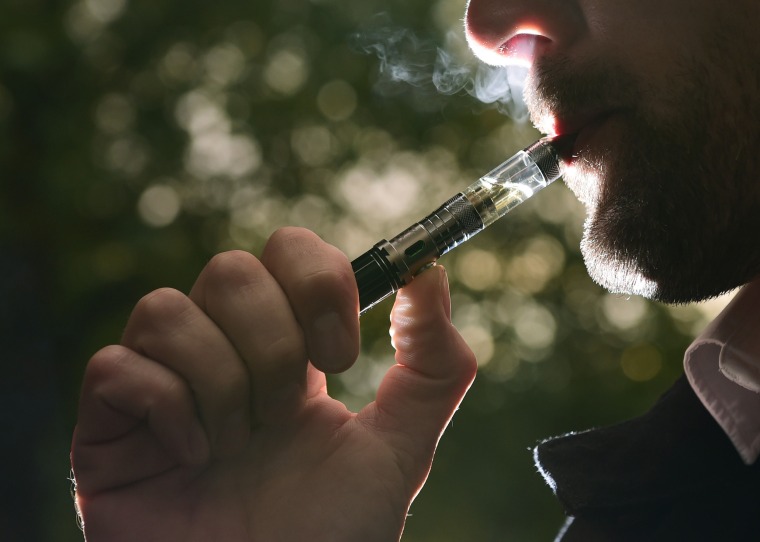The tobacco industry has been forced to fess up about the dangers of smoking by slapping grisly warnings on cigarette packs, but it hasn’t yet been cornered into giving such disclaimers on e-cigarettes and other vaping products. According to the Centers for Disease Control (CDC), American youth are now more likely to use e-cigarettes than any other form of tobacco. In 2016, more than two million middle and high school students used e-cigarettes each month.
There’s a perception that e-cigarettes are harmless. And while vaping is less harmful than smoking regular cigarettes, these products don’t come without risks. E-cigarettes are fairly new and we’re still learning about their long-term effects, but some of science is clear, and some of it is emerging over time. Here are four health risks worth noting:
1. Most e-cigarettes contain nicotine, the same drug found in cigarettes
Nicotine has known damaging effects: It’s addictive, toxic to developing fetuses and can harm brain development in children and young adults up to the age of 20.
2. E-cigarette aerosol can harm the body
The substance that e-cigarette users breathe in and exhale can contain harmful and potentially harmful substances like nicotine, chemicals and heavy metals. Because these products aren’t regulated, it’s impossible to know what’s in an e-cigarette.
A recent study, conducted by UNC School of Medicine and published in the American Thoracic Society’s American Journal of Respiratory and Critical Care Medicine, found that not only do e-cigarettes trigger the same immune responses that normal cigarettes do; they spur unique immune responses, too. It comes down to how our bodies process foreign substances.
Dr. Pushan Jani, a pulmonologist at Memorial Hermann-Texas Medical Center and UTHealth, explains that when our lungs sense something not quite right is going on, our immune system rushes in to attack.
“Common sense would tell you [that vaping] leads to inflammation within the lung,” says Dr. Cedric “Jamie“ Rutland, a pulmonary and critical care physician and assistant clinical professor at University of California at Riverside School of Medicine. This reaction can happen “even if you’re smoking just pure water vapor with no nicotine,” says Jani.
3. E-cigarettes can cause injuries
It doesn’t happen very often, but e-cigarette batteries have malfunctioned, causing burns on hands and face and other bodily injuries, some as recently as last year. Also, children and adults have been poisoned by swallowing, breathing or absorbing e-cigarette liquid through their skin or eyes, according to the CDC.
4. Flavorings can target the very young
“The flavoring industry is huge and these are chemicals that are known to have reasonable safety when eaten and exposed to the GI tract, but the lungs are very different,” says Dr. Robert Jackler, chair of otolaryngology and a professor of otorhinolaryngology at Stanford. “We know in certain industrial settings where people are producing them, they’re quite dangerous to breathe in.”
But unknown health risks aren’t the only reason Dr. Jackler takes issue with the flavoring of e-cigarettes, he’s also troubled because he understands that part of the tobacco industry’s purpose in advertising fun flavors is to draw in young people.
E-cigarette usage has been increasing among teens over the past five years, and flavoring is a huge appeal, with a 2016 study finding that some adolescents perceive the fruit flavored e-cigarettes to be less harmful than those that are tobacco-flavored. “The tobacco industry wants people to start young and knows that what really attracts them are sweet and fruity flavors,” says Jackler. “If all that were available was bitter tobacco that could be revolting.”
The American Lung Association (ALA) has been keeping a close eye on the teenage attraction to vaping and is campaigning for the same federal regulations for e-cigarettes that exist for other tobacco products. “We're trying hard to encourage the FDA to promulgate regulations of vaping,” says Norman H. Edelman senior scientific advisor at the ALA. “Right now it’s all local jurisdiction.”
What About E-Cigarettes for Smoking Cessation?
If you’re tempted to make the switch from regular cigarettes, know this: e-cigarettes are not currently approved by the FDA as a smoking cessation tool and studies have had inconsistent results. Experts recommend nicotine replacement therapy like patches, gum, lozenges and inhalers that deliver a small, controlled amount of nicotine to help satisfy cravings and reduce the urge to smoke.
“The balance of evidence still shows e-cigarettes are less damaging to health than smoked tobacco cigarettes,” says Dr. Keith Humphreys, a psychiatrist at Stanford Health Care. “Although the reputation of e-cigarettes as harmless is not warranted and is a product of industry hype, they are less deadly than smoked cigarettes which after all will kill over 450,000 Americans this year.”
But as the CDC says, if you haven’t started smoking or vaping, don’t start now.
Want more tips like these? NBC News BETTER is obsessed with finding easier, healthier and smarter ways to live. Sign up for our newsletter and follow us on Facebook, Twitter and Instagram.
